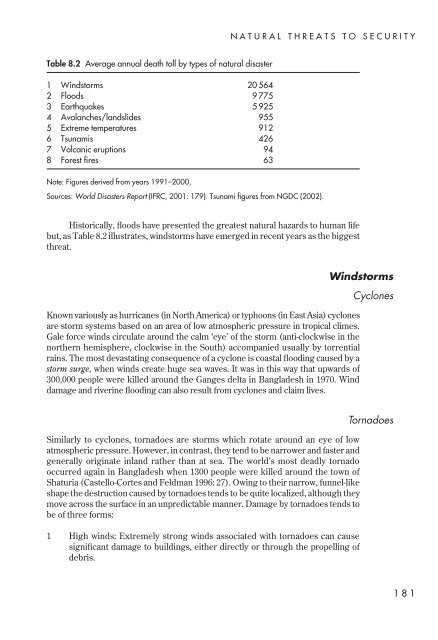- Page 2:
Understanding Global Security Globa
- Page 5 and 6:
For Lisa, Daisy and Rosie First pub
- Page 7 and 8:
CONTENTS 3 Military threats to secu
- Page 9 and 10:
CONTENTS Key points 229 Recommended
- Page 11 and 12:
Tables 1.1 Fears of individuals liv
- Page 13 and 14:
ACKNOWLEDGEMENTS Frances Say, for l
- Page 15 and 16:
ACRONYMS FARC GAVI GDP GHS GOARN GP
- Page 18 and 19:
Chapter 1 Security and securitizati
- Page 20 and 21:
SECURITY AND SECURITIZATION Classic
- Page 22 and 23:
SECURITY AND SECURITIZATION interes
- Page 24 and 25:
SECURITY AND SECURITIZATION on the
- Page 26 and 27:
SECURITY AND SECURITIZATION Chapter
- Page 28 and 29:
SECURITY AND SECURITIZATION promoti
- Page 30 and 31:
SECURITY AND SECURITIZATION securit
- Page 32 and 33:
SECURITY AND SECURITIZATION As stat
- Page 34 and 35:
SECURITY AND SECURITIZATION In this
- Page 36 and 37:
SECURITY AND SECURITIZATION The wor
- Page 38 and 39:
Chapter 2 Military threats to secur
- Page 40 and 41:
MILITARY THREATS TO SECURITY FROM S
- Page 42 and 43:
MILITARY THREATS TO SECURITY FROM S
- Page 44 and 45:
MILITARY THREATS TO SECURITY FROM S
- Page 46 and 47:
MILITARY THREATS TO SECURITY FROM S
- Page 48 and 49:
MILITARY THREATS TO SECURITY FROM S
- Page 50 and 51:
MILITARY THREATS TO SECURITY FROM S
- Page 52 and 53:
MILITARY THREATS TO SECURITY FROM S
- Page 54 and 55:
MILITARY THREATS TO SECURITY FROM S
- Page 56 and 57:
MILITARY THREATS TO SECURITY FROM S
- Page 58 and 59:
MILITARY THREATS TO SECURITY FROM S
- Page 60 and 61:
MILITARY THREATS TO SECURITY FROM S
- Page 62 and 63:
MILITARY THREATS TO SECURITY FROM S
- Page 64 and 65:
MILITARY THREATS TO SECURITY FROM S
- Page 66 and 67:
MILITARY THREATS TO SECURITY FROM S
- Page 68 and 69:
MILITARY THREATS TO SECURITY FROM S
- Page 70 and 71:
MILITARY THREATS TO SECURITY FROM S
- Page 72 and 73:
MILITARY THREATS TO SECURITY FROM S
- Page 74 and 75:
MILITARY THREATS TO SECURITY FROM S
- Page 76:
MILITARY THREATS TO SECURITY FROM S
- Page 79 and 80:
MILITARY THREATS FROM NON-STATE ACT
- Page 81 and 82:
MILITARY THREATS FROM NON-STATE ACT
- Page 83 and 84:
MILITARY THREATS FROM NON-STATE ACT
- Page 85 and 86:
MILITARY THREATS FROM NON-STATE ACT
- Page 87 and 88:
MILITARY THREATS FROM NON-STATE ACT
- Page 89 and 90:
MILITARY THREATS FROM NON-STATE ACT
- Page 91 and 92:
MILITARY THREATS FROM NON-STATE ACT
- Page 93 and 94:
MILITARY THREATS FROM NON-STATE ACT
- Page 95 and 96:
MILITARY THREATS FROM NON-STATE ACT
- Page 97 and 98:
MILITARY THREATS FROM NON-STATE ACT
- Page 99 and 100:
MILITARY THREATS FROM NON-STATE ACT
- Page 101 and 102:
ECONOMIC THREATS TO SECURITY We hav
- Page 103 and 104:
ECONOMIC THREATS TO SECURITY Table
- Page 105 and 106:
ECONOMIC THREATS TO SECURITY govern
- Page 107 and 108:
ECONOMIC THREATS TO SECURITY Develo
- Page 109 and 110:
ECONOMIC THREATS TO SECURITY e f g
- Page 111 and 112:
ECONOMIC THREATS TO SECURITY premie
- Page 113 and 114:
ECONOMIC THREATS TO SECURITY 1990:
- Page 115 and 116:
ECONOMIC THREATS TO SECURITY of the
- Page 117 and 118:
ECONOMIC THREATS TO SECURITY paradi
- Page 119 and 120:
ECONOMIC THREATS TO SECURITY statec
- Page 122 and 123:
Chapter 5 Social identity as a thre
- Page 124 and 125:
SOCIAL IDENTITY AS A THREAT TO SECU
- Page 126 and 127:
SOCIAL IDENTITY AS A THREAT TO SECU
- Page 128 and 129:
SOCIAL IDENTITY AS A THREAT TO SECU
- Page 130 and 131:
SOCIAL IDENTITY AS A THREAT TO SECU
- Page 132 and 133:
SOCIAL IDENTITY AS A THREAT TO SECU
- Page 134 and 135:
SOCIAL IDENTITY AS A THREAT TO SECU
- Page 136 and 137:
SOCIAL IDENTITY AS A THREAT TO SECU
- Page 138 and 139:
SOCIAL IDENTITY AS A THREAT TO SECU
- Page 140 and 141:
SOCIAL IDENTITY AS A THREAT TO SECU
- Page 142 and 143:
SOCIAL IDENTITY AS A THREAT TO SECU
- Page 144 and 145:
SOCIAL IDENTITY AS A THREAT TO SECU
- Page 146 and 147:
SOCIAL IDENTITY AS A THREAT TO SECU
- Page 148 and 149: SOCIAL IDENTITY AS A THREAT TO SECU
- Page 150 and 151: Chapter 6 Environmental threats to
- Page 152 and 153: ENVIRONMENTAL THREATS TO SECURITY a
- Page 154 and 155: ENVIRONMENTAL THREATS TO SECURITY B
- Page 156 and 157: ENVIRONMENTAL THREATS TO SECURITY D
- Page 158 and 159: ENVIRONMENTAL THREATS TO SECURITY a
- Page 160 and 161: ENVIRONMENTAL THREATS TO SECURITY
- Page 162 and 163: ENVIRONMENTAL THREATS TO SECURITY a
- Page 164 and 165: ENVIRONMENTAL THREATS TO SECURITY P
- Page 166 and 167: ENVIRONMENTAL THREATS TO SECURITY w
- Page 168 and 169: ENVIRONMENTAL THREATS TO SECURITY e
- Page 170 and 171: Chapter 7 Health threats to securit
- Page 172 and 173: HEALTH THREATS TO SECURITY Table 7.
- Page 174 and 175: HEALTH THREATS TO SECURITY accompan
- Page 176 and 177: HEALTH THREATS TO SECURITY Global e
- Page 178 and 179: HEALTH THREATS TO SECURITY Table 7.
- Page 180 and 181: HEALTH THREATS TO SECURITY World He
- Page 182 and 183: HEALTH THREATS TO SECURITY Box 7.1
- Page 184 and 185: HEALTH THREATS TO SECURITY continue
- Page 186 and 187: HEALTH THREATS TO SECURITY of minim
- Page 188 and 189: HEALTH THREATS TO SECURITY The rece
- Page 190 and 191: HEALTH THREATS TO SECURITY The glob
- Page 192 and 193: HEALTH THREATS TO SECURITY Greater
- Page 194: HEALTH THREATS TO SECURITY • Glob
- Page 197: NATURAL THREATS TO SECURITY We cann
- Page 201 and 202: NATURAL THREATS TO SECURITY Avalanc
- Page 203 and 204: NATURAL THREATS TO SECURITY of hydr
- Page 205 and 206: NATURAL THREATS TO SECURITY Better
- Page 207 and 208: NATURAL THREATS TO SECURITY correla
- Page 209 and 210: NATURAL THREATS TO SECURITY Humanit
- Page 211 and 212: NATURAL THREATS TO SECURITY Conclus
- Page 213 and 214: NATURAL THREATS TO SECURITY relief
- Page 216 and 217: Chapter 9 Accidental threats to sec
- Page 218 and 219: ACCIDENTAL THREATS TO SECURITY Howe
- Page 220 and 221: ACCIDENTAL THREATS TO SECURITY Tita
- Page 222 and 223: ACCIDENTAL THREATS TO SECURITY in t
- Page 224 and 225: ACCIDENTAL THREATS TO SECURITY Prop
- Page 226 and 227: ACCIDENTAL THREATS TO SECURITY the
- Page 228 and 229: ACCIDENTAL THREATS TO SECURITY Nucl
- Page 230 and 231: ACCIDENTAL THREATS TO SECURITY Such
- Page 232: Chapter 10 Criminal threats to secu
- Page 235 and 236: CRIMINAL THREATS TO SECURITY When I
- Page 237 and 238: CRIMINAL THREATS TO SECURITY also r
- Page 239 and 240: CRIMINAL THREATS TO SECURITY Nearly
- Page 241 and 242: CRIMINAL THREATS TO SECURITY fully-
- Page 243 and 244: CRIMINAL THREATS TO SECURITY of dec
- Page 245 and 246: CRIMINAL THREATS TO SECURITY ration
- Page 247 and 248: CRIMINAL THREATS TO SECURITY • In
- Page 249 and 250:
TOWARDS GLOBAL SECURITY Human secur
- Page 251 and 252:
TOWARDS GLOBAL SECURITY selected de
- Page 253 and 254:
TOWARDS GLOBAL SECURITY states, rav
- Page 255 and 256:
TOWARDS GLOBAL SECURITY liberalism
- Page 257 and 258:
TOWARDS GLOBAL SECURITY • A resto
- Page 259 and 260:
GLOSSARY Fourth World the least dev
- Page 261 and 262:
GLOSSARY their dominance of interna
- Page 263 and 264:
BIBLIOGRAPHY Ashdown, P. (2001) ‘
- Page 265 and 266:
BIBLIOGRAPHY Davis, M. and Gray, C.
- Page 267 and 268:
BIBLIOGRAPHY Haas, P. (1989) ‘Do
- Page 269 and 270:
BIBLIOGRAPHY Koivusalo, M. and Olli
- Page 271 and 272:
BIBLIOGRAPHY Natsios, A. (1999) ‘
- Page 273 and 274:
BIBLIOGRAPHY Schweller, R. (2001)
- Page 275 and 276:
BIBLIOGRAPHY Werner, D. (2001) ‘W
- Page 277 and 278:
Index Abbasi, K. 169, 170 Abrams, A
- Page 279 and 280:
INDEX cold waves 184 collective sec
- Page 281 and 282:
INDEX Global Outbreak and Alert Res
- Page 283 and 284:
INDEX Lee, K. 235 legislation as re
- Page 285 and 286:
INDEX Partnership for Peace 52 Peet
- Page 287 and 288:
INDEX trade: crime and 222; disease
















